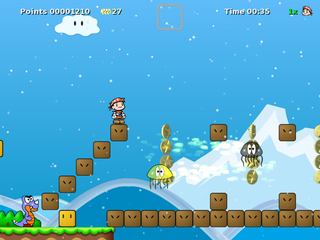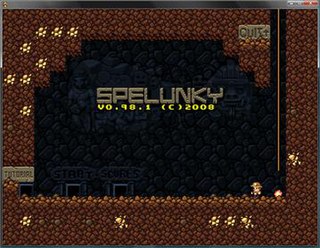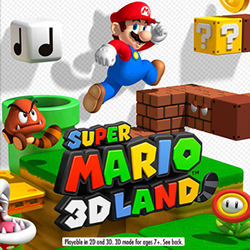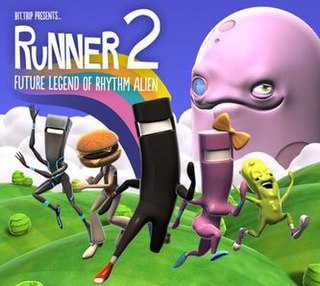
A platformer is a sub-genre of action video games in which the core objective is to move the player character between points in an environment. Platform games are characterized by levels that consist of uneven terrain and suspended platforms of varying height that require jumping and climbing to traverse. Other acrobatic maneuvers may factor into the gameplay, such as swinging from vines or grappling hooks, jumping off walls, air dashing, gliding through the air, being shot from cannons, using jet packs, or bouncing from springboards or trampolines. Games where jumping is automated completely, such as 3D games in The Legend of Zelda series, fall outside of the category.
Shoot 'em ups are a sub-genre of action games. There is no consensus as to which design elements compose a shoot 'em up; some restrict the definition to games featuring spacecraft and certain types of character movement, while others allow a broader definition including characters on foot and a variety of perspectives.

Adventures of Lolo is a puzzle video game released in 1989 by HAL Laboratory for the Nintendo Entertainment System. It is a compilation of puzzles from Eggerland: Meikyū no Fukkatsu and Eggerland: Sōzō he no Tabidachi. It is the fifth game in the Eggerland series, the third one released in Europe, but the first one released in North America. It was available on the Wii's and Wii U's Virtual Console in North America and in PAL regions, as well as on the Nintendo Switch Online's virtual Nintendo Entertainment System library.

A side-scrolling video game is a game viewed from a side-view camera angle where the screen follows the player as they move left or right. The jump from single-screen or flip-screen graphics to scrolling graphics during the golden age of arcade games was a pivotal leap in game design, comparable to the move to 3D graphics during the fifth generation.

Cake Mania is a cooking time management video game developed and published by Sandlot Games in 2006. Some ports of Cake Mania have different titles; the Wii version is known as Cake Mania: In the Mix!, and the PlayStation 2 and PlayStation Portable versions are titled Cake Mania: Bakers Challenge. Cake Mania received mixed reviews from critics, with some reviewers praising the game's 'addictive' and 'simple' casual gameplay, while others criticized this as being 'repetitive' and 'shallow'.
Prince of Persia is a video game franchise created by Jordan Mechner. It is centered around a series of action-adventure games focused on various incarnations of the eponymous Prince, set in ancient and medieval Persia.

Jeremiah D Slaczka, also known by his nickname Miah, is an American video game designer/creative director and co-founder of 5th Cell, a video game developer in Bellevue, Washington. He is best known for being the concept creator and Director of Scribblenauts as well as the million-seller hit video game Drawn to Life and 5th Cell's critically acclaimed Lock's Quest, all for the Nintendo DS. Slaczka is credited as the Director, Lead Designer, Story Writer, Original Concept Creator and Art Director for both Drawn to Life and Lock's Quest.

Scribblenauts is an emergent puzzle action video game developed by 5th Cell and published by Warner Bros. Interactive Entertainment for the Nintendo DS. The game was released in 2009 in all regions except Japan, and in 2011 in Japan as Flash Puzzle: Maxwell's Mysterious Notebook by Konami. It is the third Nintendo DS video game made by 5th Cell, the first two being Drawn to Life and Lock's Quest. The objective of Scribblenauts, as implied by its catchphrase "Write Anything, Solve Everything", is to complete puzzles to collect "Starites", helped by the player's ability to summon any object by writing its name on the touchscreen. The game is considered by its developers to help promote emergent gameplay by challenging the player to solve its puzzles within certain limitations or through multiple solutions.

Spelunky is a 2008 source-available 2D platform game created by independent developer Derek Yu and released as freeware for Microsoft Windows. It was remade for the Xbox 360 in 2012, with ports of the new version following for various platforms, including back to Microsoft Windows. The player controls a spelunker who explores a series of caves while collecting treasure, saving damsels, fighting enemies, and dodging traps. The caves are procedurally generated, making each run-through of the game unique.

Super Meat Boy is a 2010 platform game designed by Edmund McMillen and Tommy Refenes under the collective name of "Team Meat". It was self-published as the successor to Meat Boy, a 2008 Flash game designed by McMillen and Jonathan McEntee. In the game, the player controls Meat Boy, a red, cube-shaped character, as he attempts to rescue his girlfriend, Bandage Girl, from the game's antagonist Dr. Fetus. The gameplay is characterized by fine control and split-second timing, as the player runs and jumps through over 300 hazardous levels while avoiding obstacles. The game also supports the creation of player-created levels. Super Meat Boy was first released on the Xbox 360 through Xbox Live Arcade in October 2010, and was later ported to Microsoft Windows, OS X, Linux, PlayStation 4, PlayStation Vita, Wii U, and the Nintendo Switch. A Wii version was in development but was ultimately cancelled.

Silent Hill: Shattered Memories is a 2009 survival horror game developed by Climax Studios and published by Konami Digital Entertainment. It was released in December for the Wii and ported to the PlayStation 2 and PlayStation Portable platforms in January 2010. In April 2014, it appeared on the PlayStation Network in Europe.

The Adventures of Tintin: The Secret of the Unicorn is an action-adventure, platforming video game based on the film The Adventures of Tintin: The Secret of the Unicorn, which is based on the series The Adventures of Tintin, the comics series by Belgian cartoonist Hergé. The game was released for Microsoft Windows, Nintendo 3DS, PlayStation 3, Wii and Xbox 360 on 21 October 2011 in Europe, on 1 December in Australia and on 6 December in North America. The game was developed by Ubisoft Montpellier, working in collaboration with the producers of the film, and published by Ubisoft. The iOS, Android and Symbian^3 versions were published by Gameloft and released on the App Store and Android Market on 31 October 2011, and on the Ovi Store on 11 January 2012. The online services for the game were shut down on 6 October 2015.

5th Cell is an independently owned American video game developer founded in 2003 as 5th Cell Media, LLC. led by Jeremiah Slaczka and Marius Falhbusch. The company is most well known for creating the Drawn to Life and Scribblenauts series.

Sonic the Hedgehog 4: Episode I is a 2010 platform game developed by Dimps, with assistance from Sonic Team, and published by Sega. It is a sequel to Sonic & Knuckles (1994), following Sonic as he sets out to stop a returning Doctor Eggman. Like the Sonic the Hedgehog games released for the Sega Genesis, Episode I features side-scrolling gameplay, with movement restricted to a 2D plane. The player races through levels collecting rings while rolling into a ball to attack enemies. The game also features special stages in which the player collects Chaos Emeralds and online leaderboards comparing level completion times and high scores.

Infinity Blade was an action role-playing game developed by Chair Entertainment and Epic Games and released through the Apple App Store on December 9, 2010. It was the first iOS video game to run on the Unreal Engine. In the game, the unnamed player character fights a series of one-on-one battles in a derelict castle to face the immortal God King. When in battle, players swipe the screen to attack and parry, and tap the screen to dodge and block enemy attacks. Upon defeat, the player restarts the game as the character's descendant with the same items and experience level.

Super Mario 3D Land is a platform video game in the Super Mario series developed and published by Nintendo for their Nintendo 3DS handheld game console. It was released worldwide in November 2011, beginning in Japan. It was the first Mario game to be released for the 3DS.

MotoHeroz is a platform-racing video game developed and self-published by Ubisoft RedLynx. It was released as a digital download on September 15, 2011 for the Nintendo Wii via its WiiWare service, March 15, 2012 for iOS devices, and September 26, 2013 for Android.

Scribblenauts Unlimited is a puzzle sandbox video game developed by 5th Cell and published by Warner Bros. Interactive Entertainment for the Nintendo 3DS, Wii U, Microsoft Windows, iOS and Android. The game was announced during Nintendo's E3 2012 press conference on June 5. It is the fourth title in the Scribblenauts series, as a launch title for the Wii U console.

Bit.Trip Presents... Runner2: Future Legend of Rhythm Alien, generally shortened as Runner2, is a 2013 side-scrolling platformer developed by Gaijin Games. The game is the direct sequel to Bit.Trip Runner and has been released as a downloadable title available on the PlayStation 3, PlayStation Vita, Xbox 360 and Wii U consoles, Microsoft Windows, OS X, Linux and on iOS, as well as PlayStation 4 in 2016. The PC, Mac, Linux, and Wii U versions were self-published by Gaijin Games, and the Xbox 360 and PlayStation 3 versions were published by Aksys Games.
Scribblenauts is a series of action puzzle video games primarily developed by independent studio 5th Cell. The series is owned and published by Warner Bros. Interactive Entertainment. The first game in the series was titled Scribblenauts and was first released on September 15, 2009, in North America, exclusively on the Nintendo DS. Since the release of the first game, five other Scribblenauts games have been released, in addition to two compilations and two comic adaptations.
















